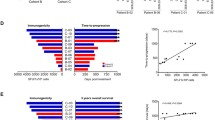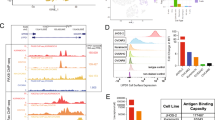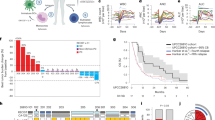Abstract
Epithelial ovarian cancer is an aggressive malignancy, with a low 5-year median survival. Continued improvement on the development of more effective therapies depends in part on the availability of adequate preclinical models for in vivo testing of treatment efficacy. Mucin 1 (MUC1) glycoprotein is a tumor-associated antigen overexpressed in ovarian cancer cells, making it a potential target for immune therapy. To create a preclinical mouse model for MUC1-positive ovarian tumors, we generated triple transgenic (Tg) mice that heterozygously express human MUC1+/− as a transgene, and carry the conditional K-rasG12D oncoallele (loxP-Stop-loxP-K-rasG12D/+) and the floxed Pten gene (Pten/loxP/loxP). Injection of Cre recombinase-encoding adenovirus (AdCre) in the ovarian bursa of triple (MUC1KrasPten) Tg mice triggers ovarian tumors that, in analogy to human ovarian cancer, express strongly elevated MUC1 levels. The tumors metastasize loco-regionally and are accompanied by high serum MUC1, closely mimicking the human disease. Compared with the KrasPten mice with tumors, the MUC1KrasPten mice show increased loco-regional metastasis and augmented accumulation of CD4+Foxp3+ immune-suppressive regulatory T cells. Vaccination of MUC1KrasPten mice with type 1 polarized dendritic cells (DC1) loaded with a MUC1 peptide (DC1–MUC1) can circumvent tumor-mediated immune suppression in the host, activate multiple immune effector genes and effectively prolong survival. Our studies report the first human MUC1-expressing, orthotopic ovarian tumor model, reveal novel MUC1 functions in ovarian cancer biology and demonstrate its suitability as a target for immune-based therapies.
This is a preview of subscription content, access via your institution
Access options
Subscribe to this journal
Receive 50 print issues and online access
$259.00 per year
only $5.18 per issue
Buy this article
- Purchase on Springer Link
- Instant access to full article PDF
Prices may be subject to local taxes which are calculated during checkout






Similar content being viewed by others
References
Shan W, Liu J . Epithelial ovarian cancer: focus on genetics and animal models. Cell Cycle 2009; 8: 731–735.
Mullany LK, Fan HY, Liu Z, White LD, Marshall A, Gunaratne P et al. Molecular and functional characteristics of ovarian surface epithelial cells transformed by KrasG12D and loss of Pten in a mouse model in vivo. Oncogene 2011; 30: 3522–3536.
Flesken-Nikitin A, Choi KC, Eng JP, Shmidt EN, Nikitin AY . Induction of carcinogenesis by concurrent inactivation of p53 and Rb1 in the mouse ovarian surface epithelium. Cancer Res 2003; 63: 3459–3463.
Boyd J . Mouse models of gynecologic pathology. N Engl J Med 2005; 352: 2240–2242.
Matzuk MM . Gynecologic diseases get their genes. Nat Med 2005; 11: 24–26.
Connolly DC, Bao R, Nikitin AY, Stephens KC, Poole TW, Hua X et al. Female mice chimeric for expression of the simian virus 40 TAg under control of the MISIIR promoter develop epithelial ovarian cancer. Cancer Res 2003; 63: 1389–1397.
Yang DH, Fazili Z, Smith ER, Cai KQ, Klein-Szanto A, Cohen C et al. Disabled-2 heterozygous mice are predisposed to endometrial and ovarian tumorigenesis and exhibit sex-biased embryonic lethality in a p53-null background. The Am J Pathol 2006; 169: 258–267.
Tanwar PS, Zhang L, Kaneko-Tarui T, Curley MD, Taketo MM, Rani P et al. Mammalian target of rapamycin is a therapeutic target for murine ovarian endometrioid adenocarcinomas with dysregulated Wnt/beta-Catenin and PTEN. PLoS One 2011; 6: e20715.
Dinulescu DM, Ince TA, Quade BJ, Shafer SA, Crowley D, Jacks T . Role of K-ras and Pten in the development of mouse models of endometriosis and endometrioid ovarian cancer. Nat Med 2005; 11: 63–70.
Fan HY, Liu Z, Paquet M, Wang J, Lydon JP, DeMayo FJ et al. Cell type-specific targeted mutations of Kras and Pten document proliferation arrest in granulosa cells versus oncogenic insult to ovarian surface epithelial cells. Cancer Res 2009; 69: 6463–6472.
Gendler SJ, Lancaster CA, Taylor-Papadimitriou J, Duhig T, Peat N, Burchell J et al. Molecular cloning and expression of human tumor-associated polymorphic epithelial mucin. J Biol Chem 1990; 265: 15286–15293.
Barnd DL, Lan MS, Metzgar RS, Finn OJ . Specific, major histocompatibility complex-unrestricted recognition of tumor-associated mucins by human cytotoxic T cells. Proc Natl Acad Sci USA 1989; 86: 7159–7163.
Ioannides CG, Fisk B, Jerome KR, Irimura T, Wharton JT, Finn OJ . Cytotoxic T cells from ovarian malignant tumors can recognize polymorphic epithelial mucin core peptides. J Immunol 1993; 151: 3693–3703.
Jerome KR, Domenech N, Finn OJ . Tumor-specific cytotoxic T cell clones from patients with breast and pancreatic adenocarcinoma recognize EBV-immortalized B cells transfected with polymorphic epithelial mucin complementary DNA. J Immunol 1993; 151: 1654–1662.
Kotera Y, Fontenot JD, Pecher G, Metzgar RS, Finn OJ . Humoral immunity against a tandem repeat epitope of human mucin MUC-1 in sera from breast, pancreatic, and colon cancer patients. Cancer Res 1994; 54: 2856–2860.
Ahmad R, Raina D, Joshi MD, Kawano T, Ren J, Kharbanda S et al. MUC1-C oncoprotein functions as a direct activator of the nuclear factor-kappaB p65 transcription factor. Cancer Res 2009; 69: 7013–7021.
Ahmad R, Raina D, Trivedi V, Ren J, Rajabi H, Kharbanda S et al. MUC1 oncoprotein activates the IkappaB kinase beta complex and constitutive NF-kappaB signalling. Nature Cell Biol 2007; 9: 1419–1427.
Li Y, Bharti A, Chen D, Gong J, Kufe D . Interaction of glycogen synthase kinase 3beta with the DF3/MUC1 carcinoma-associated antigen and beta-catenin. Mol Cell Biol 1998; 18: 7216–7224.
Li Y, Kuwahara H, Ren J, Wen G, Kufe D . The c-Src tyrosine kinase regulates signaling of the human DF3/MUC1 carcinoma-associated antigen with GSK3 beta and beta-catenin. J Biol Chem 2001; 276: 6061–6064.
Wei X, Xu H, Kufe D . Human MUC1 oncoprotein regulates p53-responsive gene transcription in the genotoxic stress response. Cancer Cell 2005; 7: 167–178.
Yamamoto M, Bharti A, Li Y, Kufe D . Interaction of the DF3/MUC1 breast carcinoma-associated antigen and beta-catenin in cell adhesion. J Biol Chem 1997; 272: 12492–12494.
Besmer DM, Curry JM, Roy LD, Tinder TL, Sahraei M, Schettini J et al. Pancreatic ductal adenocarcinoma mice lacking mucin 1 have a profound defect in tumor growth and metastasis. Cancer Res 2011; 71: 4432–4442.
Rustin GJ, Bast RC, Kelloff GJ, Barrett JC, Carter SK, Nisen PD et al. Use of CA-125 in clinical trial evaluation of new therapeutic drugs for ovarian cancer. Clinical Cancer Res 2004; 10: 3919–3926.
Karam AK, Karlan BY . Ovarian cancer: the duplicity of CA125 measurement. Nat Rev Clin Oncol 2010; 7: 335–339.
Reinartz S, Failer S, Schuell T, Wagner U . CA125 (MUC16) gene silencing suppresses growth properties of ovarian and breast cancer cells. European J Cancer 2011; 48: 1558–1569.
Theriault C, Pinard M, Comamala M, Migneault M, Beaudin J, Matte I et al. MUC16 (CA125) regulates epithelial ovarian cancer cell growth, tumorigenesis and metastasis. Gynecol Oncol 2011; 121: 434–443.
Brayman M, Thathiah A, Carson DD . MUC1: a multifunctional cell surface component of reproductive tissue epithelia. Reprod Biol Endocrinol: RB&E 2004; 2: 4.
Feng H, Ghazizadeh M, Konishi H, Araki T . Expression of MUC1 and MUC2 mucin gene products in human ovarian carcinomas. Jpn J Clin Oncol 2002; 32: 525–529.
Ho SB, Niehans GA, Lyftogt C, Yan PS, Cherwitz DL, Gum ET et al. Heterogeneity of mucin gene expression in normal and neoplastic tissues. Cancer Res 1993; 53: 641–651.
Lau SK, Weiss LM, Chu PG . Differential expression of MUC1, MUC2, and MUC5AC in carcinomas of various sites: an immunohistochemical study. Am J Clin Pathol 2004; 122: 61–69.
Lu KH, Patterson AP, Wang L, Marquez RT, Atkinson EN, Baggerly KA et al. Selection of potential markers for epithelial ovarian cancer with gene expression arrays and recursive descent partition analysis. Clin Cancer Res 2004; 10: 3291–3300.
Van Elssen CH, Frings PW, Bot FJ, Van de Vijver KK, Huls MB, Meek B et al. Expression of aberrantly glycosylated Mucin-1 in ovarian cancer. Histopathology 2010; 57: 597–606.
Rowse GJ, Tempero RM, VanLith ML, Hollingsworth MA, Gendler SJ . Tolerance and immunity to MUC1 in a human MUC1 transgenic murine model. Cancer Res 1998; 58: 315–321.
Budiu RA, Diaconu I, Chrissluis R, Dricu A, Edwards RP, Vlad AM . A conditional mouse model for human MUC1-positive endometriosis shows the presence of anti-MUC1 antibodies and Foxp3+ regulatory T cells. Dis Mod Mech 2009; 2: 593–603.
Budiu RA, Mantia-Smaldone G, Elishaev E, Chu T, Thaller J, McCabe K et al. Soluble MUC1 and serum MUC1-specific antibodies are potential prognostic biomarkers for platinum-resistant ovarian cancer. Cancer Immunol Immunother 2011; 60: 975–984.
Roby KF, Taylor CC, Sweetwood JP, Cheng Y, Pace JL, Tawfik O et al. Development of a syngeneic mouse model for events related to ovarian cancer. Carcinogenesis 2000; 21: 585–591.
Curiel TJ, Coukos G, Zou L, Alvarez X, Cheng P, Mottram P et al. Specific recruitment of regulatory T cells in ovarian carcinoma fosters immune privilege and predicts reduced survival. Nat Med 2004; 10: 942–949.
Kryczek I, Wei S, Zhu G, Myers L, Mottram P, Cheng P et al. Relationship between B7-H4, regulatory T cells, and patient outcome in human ovarian carcinoma. Cancer Res 2007; 67: 8900–8905.
Sato E, Olson SH, Ahn J, Bundy B, Nishikawa H, Qian F et al. Intraepithelial CD8+ tumor-infiltrating lymphocytes and a high CD8+/regulatory T cell ratio are associated with favorable prognosis in ovarian cancer. Proc Natl Acad Sci USA 2005; 102: 18538–18543.
Ryan SO, Vlad AM, Islam K, Gariepy J, Finn OJ . Tumor-associated MUC1 glycopeptide epitopes are not subject to self-tolerance and improve responses to MUC1 peptide epitopes in MUC1 transgenic mice. Biol Chem 2009; 390: 611–618.
Giermasz AS, Urban JA, Nakamura Y, Watchmaker P, Cumberland RL, Gooding W et al. Type-1 polarized dendritic cells primed for high IL-12 production show enhanced activity as cancer vaccines. Cancer Immunol Immunother 2009; 58: 1329–1336.
Vlad AM, Muller S, Cudic M, Paulsen H, Otvos L, Hanisch FG et al. Complex carbohydrates are not removed during processing of glycoproteins by dendritic cells: processing of tumor antigen MUC1 glycopeptides for presentation to major histocompatibility complex class II-restricted T cells. J Exp Med 2002; 196: 1435–1446.
Cheever MA, Allison JP, Ferris AS, Finn OJ, Hastings BM, Hecht TT et al. The prioritization of cancer antigens: a national cancer institute pilot project for the acceleration of translational research. Clin Cancer Res 2009; 15: 5323–5337.
Spicer AP, Parry G, Patton S, Gendler SJ . Molecular cloning and analysis of the mouse homologue of the tumor-associated mucin, MUC1, reveals conservation of potential O-glycosylation sites, transmembrane, and cytoplasmic domains and a loss of minisatellite-like polymorphism. J Biol Chem 1991; 266: 15099–15109.
Beatty PL, Plevy SE, Sepulveda AR, Finn OJ . Cutting edge: transgenic expression of human MUC1 in IL-10-/- mice accelerates inflammatory bowel disease and progression to colon cancer. J Immunol 2007; 179: 735–739.
Tinder TL, Subramani DB, Basu GD, Bradley JM, Schettini J, Million A et al. MUC1 enhances tumor progression and contributes toward immunosuppression in a mouse model of spontaneous pancreatic adenocarcinoma. J Immunol 2008; 181: 3116–3125.
Polyak K, Weinberg RA . Transitions between epithelial and mesenchymal states: acquisition of malignant and stem cell traits. Nat Rev Cancer 2009; 9: 265–273.
Vergara D, Merlot B, Lucot JP, Collinet P, Vinatier D, Fournier I et al. Epithelial-mesenchymal transition in ovarian cancer. Cancer Lett 2010; 291: 59–66.
Roy LD, Sahraei M, Subramani DB, Besmer D, Nath S, Tinder TL et al. MUC1 enhances invasiveness of pancreatic cancer cells by inducing epithelial to mesenchymal transition. Oncogene 2011; 30: 1449–1459.
Allavena P, Chieppa M, Bianchi G, Solinas G, Fabbri M, Laskarin G et al. Engagement of the mannose receptor by tumoral mucins activates an immune suppressive phenotype in human tumor-associated macrophages. Clin Dev Immunol 2010; 2010: 547179.
Kandalaft LE, Powell DJ, Singh N, Coukos G . Immunotherapy for ovarian cancer: what's next? J Clin Oncol 2011; 29: 925–933.
Palucka K, Ueno H, Banchereau J . Recent developments in cancer vaccines. J Immunol 2011; 186: 1325–1331.
Odunsi K, Sabbatini P . Harnessing the immune system for ovarian cancer therapy. Am J Reprod Immunol 2008; 59: 62–74.
Chen D, Koido S, Li Y, Gendler S, Gong J . T cell suppression as a mechanism for tolerance to MUC1 antigen in MUC1 transgenic mice. Breast Cancer Res Treat 2000; 60: 107–115.
Wei C, Willis RA, Tilton BR, Looney RJ, Lord EM, Barth RK et al. Tissue-specific expression of the human prostate-specific antigen gene in transgenic mice: implications for tolerance and immunotherapy. Proc Natl Acad Sci USA 1997; 94: 6369–6374.
Melief CJ . Cancer immunotherapy by dendritic cells. Immunity 2008; 29: 372–383.
Kurman RJ, Shih Ie M. . Molecular pathogenesis and extraovarian origin of epithelial ovarian cancer--shifting the paradigm. Hum Pathol 2011; 42: 918–931.
Vlad AM, Diaconu I, Gantt K . MUC1 in endometriosis and ovarian cancer. Immunol Res 2006; 36: 229–236.
Lesche R, Groszer M, Gao J, Wang Y, Messing A, Sun H et al. Cre/loxP-mediated inactivation of the murine Pten tumor suppressor gene. Genesis 2002; 32: 148–149.
Hiltbold EM, Vlad AM, Ciborowski P, Watkins SC, Finn OJ . The mechanism of unresponsiveness to circulating tumor antigen MUC1 is a block in intracellular sorting and processing by dendritic cells. J Immunol 2000; 165: 3730–3741.
Acknowledgements
We would like to thank Dr Daniela Dinulescu for discussion on various aspects of the mouse model, Dr Olivera Finn for critical review of the paper and Julia Thaller for technical assistance with histology work. This study was supported by the Department of Defense Ovarian Cancer Academy Award, Pennsylvania Department of Health, Scaife Foundation and NIH/NCI 1 R01 CA163462-01 (to AMV).
Author information
Authors and Affiliations
Corresponding author
Ethics declarations
Competing interests
The authors declare no conflict of interest.
Additional information
Supplementary Information accompanies the paper on the Oncogene website
Rights and permissions
About this article
Cite this article
Budiu, R., Elishaev, E., Brozick, J. et al. Immunobiology of human mucin 1 in a preclinical ovarian tumor model. Oncogene 32, 3664–3675 (2013). https://doi.org/10.1038/onc.2012.397
Received:
Accepted:
Published:
Issue Date:
DOI: https://doi.org/10.1038/onc.2012.397
Keywords
This article is cited by
-
Cisplatin-induced immune modulation in ovarian cancer mouse models with distinct inflammation profiles
Oncogene (2019)
-
Promoting the accumulation of tumor-specific T cells in tumor tissues by dendritic cell vaccines and chemokine-modulating agents
Nature Protocols (2018)
-
Effects of Kras activation and Pten deletion alone or in combination on MUC1 biology and epithelial-to-mesenchymal transition in ovarian cancer
Oncogene (2016)
-
Anti-PD-L1 prolongs survival and triggers T cell but not humoral anti-tumor immune responses in a human MUC1-expressing preclinical ovarian cancer model
Cancer Immunology, Immunotherapy (2015)
-
Emerging roles of regulatory T cells in tumour progression and metastasis
Cancer and Metastasis Reviews (2014)



